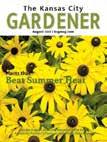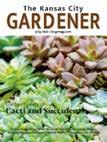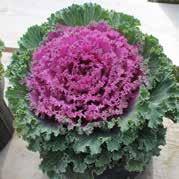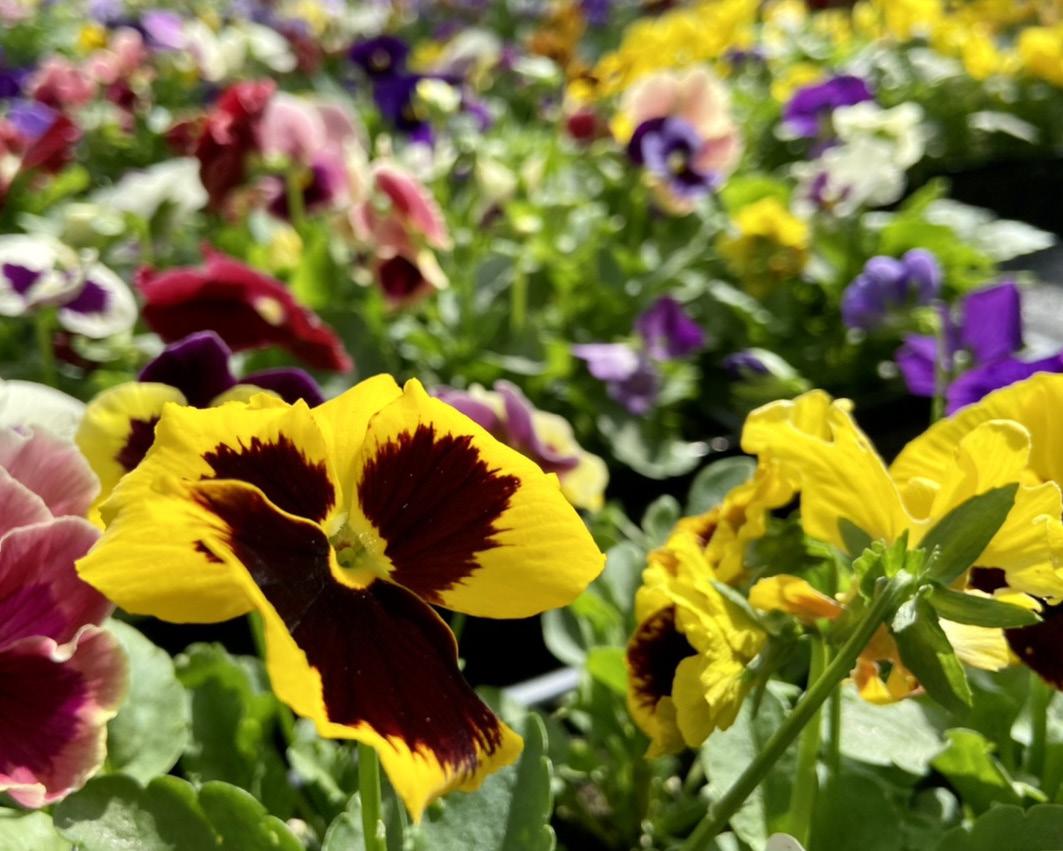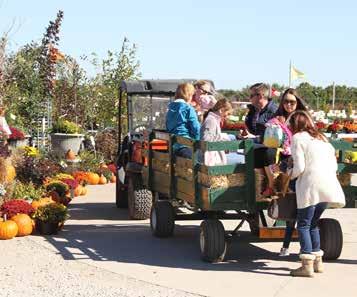
The Kansas City


The Kansas City
Independently owned and operated since 1996
PUBLISHER
Michael Cavanaugh
EDITOR
Elizabeth Cavanaugh

CONTRIBUTORS
Natalie Carmolli
Glenn Hodges
Sean Holland
Lenora Larson
Susan Mertz
Jason Mispagel
Dennis Patton
Tamra Reall
Scott Woodbury
DISTRIBUTION
Publishers Delivery Solutions, Inc.
IF YOU WOULD LIKE TO DISTRIBUTE the magazine at your place of business, please contact Mike Cavanaugh at mike@kcgmag.com 913-648-4728
NEED MORE MAGAZINES? mike@kcgmag.com 913-648-4728
CONTACT US P.O. Box 8725 Prairie Village, KS 66208 913-648-4728

ADVERTISING Mike Cavanaugh at mike@kcgmag.com 913-648-4728
EDITORIAL
Elizabeth Cavanaugh elizabeth@kcgmag.com 913-648-4728
See details on page 23.
SUBSCRIPTION
Elizabeth Cavanaugh elizabeth@kcgmag.com 913-648-4728

WEBSITE kcgmag.com
Recently Mr. Gardener and I were out in the garden, trying to make headway on weed ing. And because we had watered the day before, the soil was work able, making weeds easier to pull. Our neighbors have commented on our attire, “You look like a profes sional landscape crew.” Of course, it helps that our wide-brimmed hats, pants and long-sleeved, col lared shirts look similar. We are fashionable if nothing else. That’s all part of the process, right?
It was early in the day, I’m dressed and prepared to spend a few hours in the garden tackling that weeding chore. Mostly it is the multitude of baby oak trees that have infiltrated the landscape. It has been a banner year for those seedlings, growing up through the liriope and underneath the hosta leaves.
A note for beginners: a nice thick layer of MULCH is the key to success in keeping weeds at bay.
With the collection bucket, brown paper bags, tools if needed, and water to keep me hydrated, I’m ready.
After spending what I consid ered a decent amount of time on the job, my enthusiasm began to wane. My back was aching. The sun was hot. I was thirsty, and finally said, “This isn’t as much fun as I thought it was going to be.”
That statement may not seem funny now, but at the time I tickled myself, and started to laugh out loud. To myself I said, “You thought weeding was going to be fun?”
Entering the tongue-incheek humor zone.
Which lead me down the path to all the often silly things we gardeners say in the garden. Like “Where are you going to put that?” and of course the natural response is “Don’t worry, I’ll find a place.”
“This is not a hospital.” In the past I’ve been known to bring home a freebie–a plant that needs TLC. And usually with a little fertil izer and it’ll perk up. Mr. Gardener doesn’t have the patience for wimpy plants.
“Sorry babe,” is what he said when I noticed my clematis was gone.
“Um, that won’t fit in my car,” she said when attempting to pur chase a patio palm for the deck.
“I don’t remember planting that.” Whether a bird dropped a seed or Mr. Gardener squeezed one in, I’m forever amazed in my gar den discoveries.
Finally, this quote (and not so humorous) ... “Where’s the dog?”
In the blink of an eye, Maggie would be wandering in the neigh bor’s yard, and before you know it my phone is ringing. A friendly neighbor has wrangled our roaming beautiful Catahoula blue, my sweet girl. At this writing, I mention her passing. Her illness was brief, and there was no suffering. Now free to stroll wherever the enticing smells take her.
see you in the garden!
In this issue October 2022 | kcgmag.com
About the cover: Discover favorite plants among garden center professionals, like this showy Fothergilla ‘Legend of the Fall’ that you might have overlooked, beginning on page 12.
It’s time to revisit the garden with fall plantings. Don’t forget to nourish with Osmocote® Smart-Release® Plant Food. It will feed your plants essential nutrients consistently and continuously throughout the autumn season.
When perfection matters, why trust anything else?
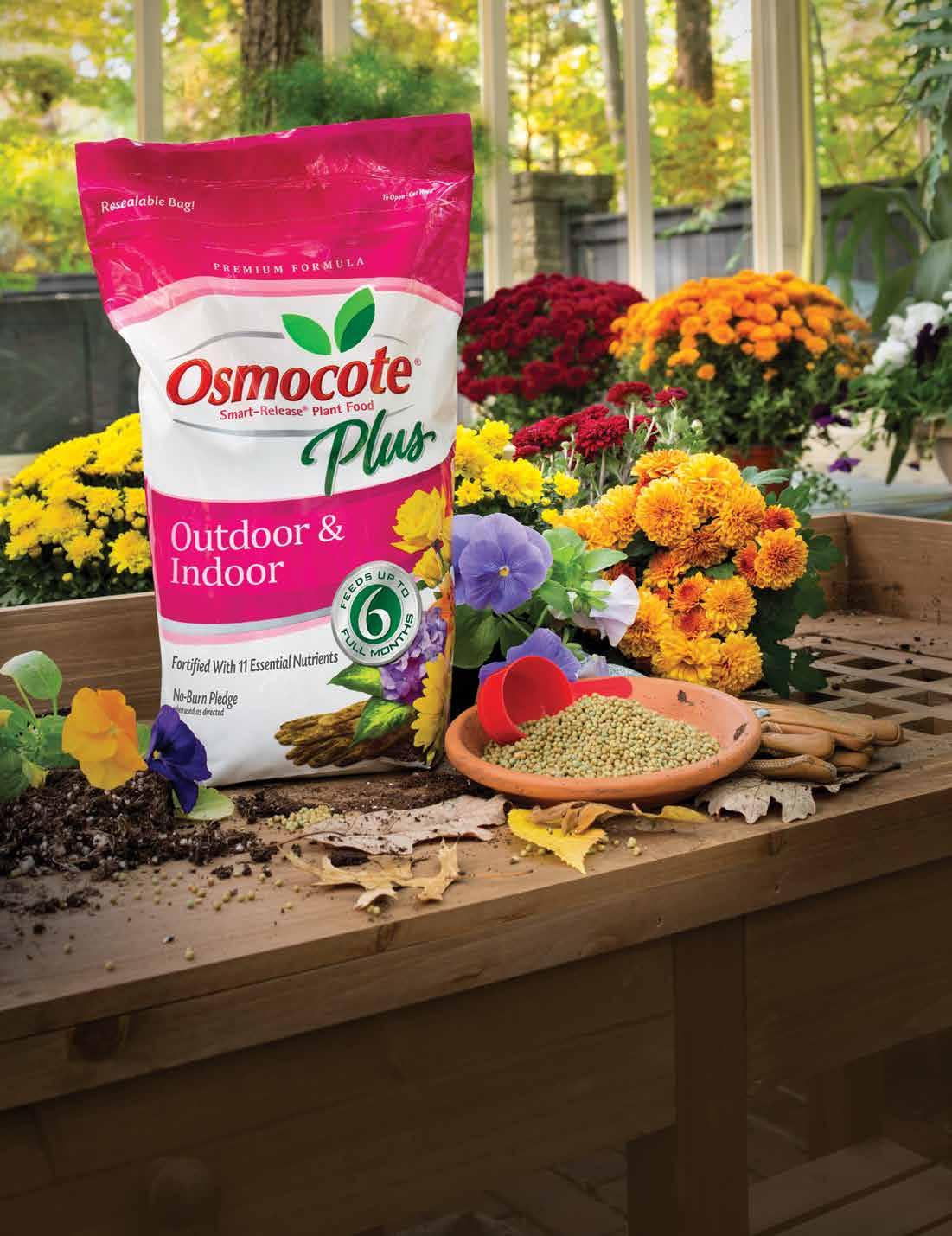
Fall in love with your garden, all over again.
Question: I have a neighbor with Hosta, Bearded Iris, and Or ange Daylilies in her garden. I was going to ask if I could have a few of each. It seems that they are all originally from Asia. My question is, is it all right to plant more in my yard or should I just plant Kansas natives?

Answer: I love this question. There is a growing movement and rightfully so to plant more native plants. I think by now most people know the many advantages of na tive plants. They are more tolerant of environmental conditions and often benefit pollinators. But does it have to be all or nothing? Some purists would say yes, only plant natives. But for most like me there is a place in the garden for both natives and non-natives. The goal would be to have the backbone of your garden include a diversity of natives and non-natives that coex ist for a healthy garden. Plant what you enjoy but don’t overlook the importance of natives and their benefits.
Question: Help, my arborvitae turned brown this summer. What happened? Is it dead?
Answer: There are several spe cies and varieties of arborvitae we grow in the landscape. The one we get the most questions on is Emer ald arborvitae. Emerald is the nar row upright variety often used for screening or narrow locations. It is a problem solver.
Unfortunately, this plant has is sues. Emerald arborvitae is not heat AND drought tolerant. This plant has a shallow root system and the combination of hot and dry can be deadly. July/August weather pat terns were not good. It can survive hot, but it must have good soil moisture. A number of these plants turned brown and died in late Au gust. This plant needs to be kept moist during hot weather or better
yet never consider it fully estab lished. Water deeply and thorough ly even under mild dry periods.
The other common arborvitae we grow is Green Giant, a larger conical tree form. It has better drought tolerance, but much like Emerald during periods of heat and dry weather supplemental watering would be recommended. I also no ticed these failing this summer.
Question: I planted a Celebrity tomato this spring. The plant grew great but when the fruits were ripe, they were small, and pear shaped. What happened? What did I do wrong?
Answer: My hunch is the plant was mislabeled and you did noth ing wrong. There are several vari eties of pear-shaped tomatoes on the market. Plants don’t just magi cally change! My take is either the grower mismarked, or someone
switched labels at the retail outlet. I have witnessed people pull tags to read and not replace, or even kids switching labels when parents were not looking. Chalk it up to a mistake and don’t let it ruin your gardening fun. Hopefully you had a good har vest and enjoyed the smaller fruit. Granted it would be disappointing not to have the yummy slicer for a BLT.
Question: What do I need to do to get my Christmas cactus to bloom?
Answer: Proper temperature and light are required for Christmas and Thanksgiving cactus to bloom. Average household temperatures are usually fine for growth and flower ing but avoid temps below 50°F, as cooler will prevent flowering.

Holiday cacti are triggered into bloom with long nights and short days. Usually requiring 25 consec
utive long nights for flower initia tion. Nights must be greater than 12 hours long, which usually begins around the Fall equinox, Septem ber 22nd.
If your plant is receiving natural sunlight, and no artificial light dur ing night hours, your plant should bloom naturally. The 25-day re quirement will be met about Oc tober 17th. If your plant does not naturally get long nights place in a dark place, such as a closet, for more than 12 hours each day to in duce flowering.
During the day, these cacti pre fer bright, indirect light. Too much sun may cause leaves to turn yel low. Their preference is constantly moist soil but avoid overwatering and waterlogged soils. Keep them a little pot bound.
After all the requirements are met, it takes another 9-10 weeks for the flowers to develop and provide blooms for the holiday season.
Question: Settle a debate please. I have learned that we only have poison ivy in the Kansas City area. Others keep telling me I am wrong, and that we also have poison oak and poison sumac. Who’s right?

Answer: I am in your camp as that is what I have learned, only poison ivy. If you look at USDA maps the information does not sup port us. Poison ivy is defiantly in the Kansas City area. By the maps both poison oak and poison sumac are in the states of Missouri and Kansas. But here is where we need to split hairs. If the plant is found in just one location by the maps than the entire state is labeled having the plant. In Kansas poison oak is found in extreme southeast Kan sas. Not in the Kansas City area. My understanding is both plants are in southern/eastern Missouri, not in the Kansas City area. If I am wrong, well it is not the first time nor will it be the last time.
DENNIS PATTON


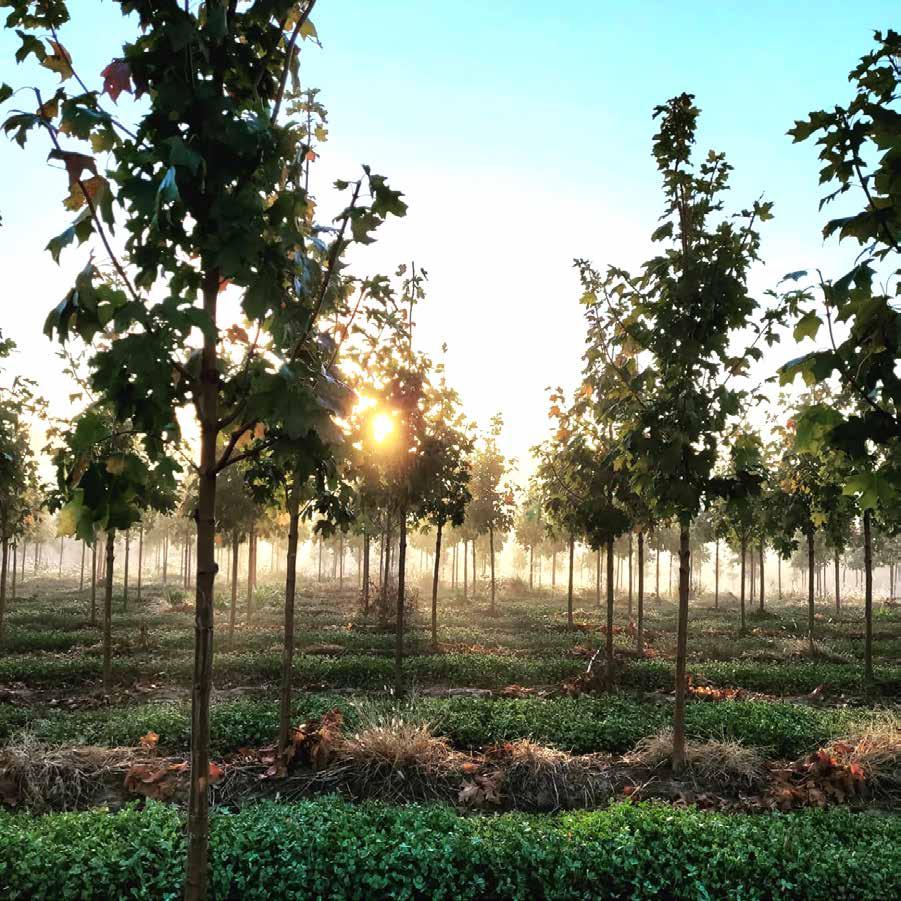
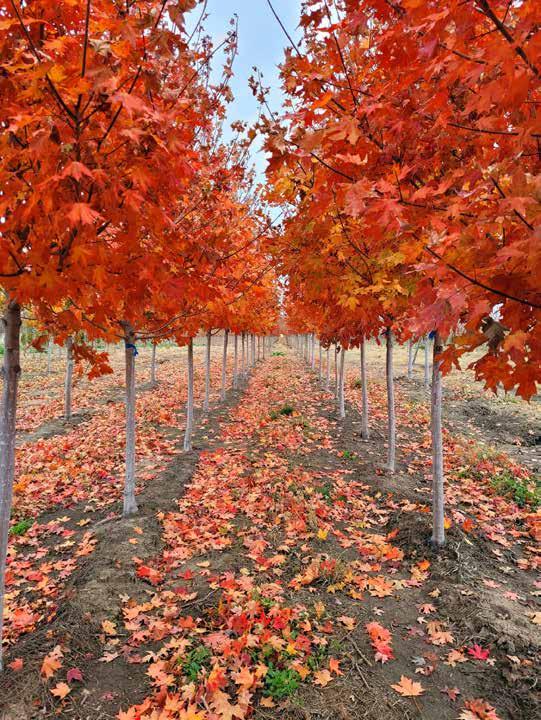

Bush honeysuckle is one of the greatest threats to our wood lands. It comes in with bird droppings, crowds out most other species, and is here to stay…unless
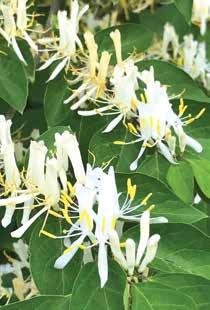
Note: Bush honeysuckle (Lonicera maackii and other nonnative shrub species of Lonicera) is a large shrub that was introduced from China to North America in the 1800s as an ornamental plant. It was used extensively for gardening and for screening and snow drift ing along highways throughout the Midwest.
…Unless we intervene with some serious elbow grease. Hon eysuckle is not easy to eradicate and keep under control, especially when it is mature and heavily in festing the woods. It produces branches 3-5 inches thick, can grow 10-15 feet tall, and eventually cov ers every square foot of woodland within reach. You can’t even walk through the woods when bush hon eysuckle has taken hold.

Note: Bush honeysuckle has no natural predators, birds eat the bright red berries in fall and spread seeds far and wide, and it grows so aggressively that it shades out ev ery other plant in the woods grow ing beneath it.
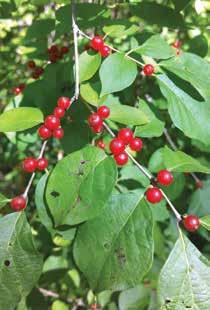
Owners of small properties (less than an acre) can control bush hon eysuckle by hand, digging up the roots of medium-sized shrubs with a mattock or shovel. This is called root docking. A video of the process is on the Deer Creek Watershed Al liance website. Small saplings, with stems a half-inch thick or smaller in diameter can be pulled by hand when the soil is moist. This makes for easy scouting once you get the big ones out of the way. But keep in mind that scouting needs to happen every year to keep them out. A great time to scout for honeysuckle is in late fall when the leaves turn yel low. They stand out like fancy dia monds on a sand bar. Note, howev er, that root docking often disturbs soil, which can lead to erosion and
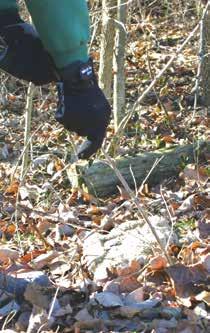
encourage the germination of bush honeysuckle seeds in the soil, along with the seeds of other invasives.
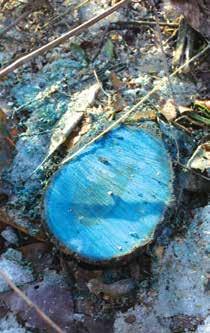
Property owners with more land may have a greater chal lenge. The City of Web ster Goves is having suc cess controlling honeysuckle at Shady Creek Nature Sanctuary using goats. These browsing ani mals love eating honeysuckle and can even devour good size shrubs.
Follow-up is recom mended to remove large branches that may remain and any resprouting foliage. Keep in mind that once the mature plants are gone, new seedlings continue to appear, so scouting annually is a must. Be aware, however, that goats will eat just about any plant, including desirable natives.


Note: Honeysuckle has a great advantage over our native wood land species, because it leafs out before canopy trees leaf out in early spring, and it holds onto its leaves into late fall, after canopy trees drop their leaves.
Commercially, heavy infesta tions of large, mature honeysuckle (on many acres), are removed us ing a forestry mower and heavyduty skid steer. This process makes short work of grinding large honey suckle shrubs to shreds, though it is
Scott Woodbury was the horticulturist at Shaw Nature Reserve for 30 years and stepped down from that position in June 2022. He continues to work on contract for Shaw Nature Reserve to carry out native landscaping education, and has launched his own business called Cacalia: Native Garden Design and Wilding.

expensive. This process is typically followed with targeted applications of glyphosate herbicide to the re sprouting foliage during the grow ing season. Mechanical removal of honeysuckle that is not followed up with glyphosate treatment is often a wasted effort. Judicial application of glyphosate on cut stems/stumps and/or on resprouting foliage the following spring can greatly bene fit native vegetation restoration ef forts. Remember, always read and follow herbicide label directions.
Large-scale woodland restora tions also may involve thinning na tive canopy trees. Determine which tree species are in greatest abun dance and start removing some of them in winter.

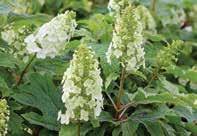
Typically, native elm, boxelder, shingle oak, white and green ash






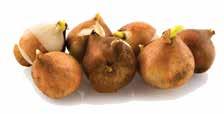

are in abundance. You may need to remove 20-30% of the canopy trees to open up the woodlands enough for better airflow, increased sunlight, and stronger growth of perennials and grasses, all of which will encourage fewer honeysuckle shrubs in the future, especially if you scout for new seedlings an nually and conduct a prescribed burn.

Seek out a qualified restoration contractor in the Grow Native! re source guide. There are some great examples of these kinds of wood land restorations just west of the Jewel Box at Forest Park in St. Louis, and just west of the Whit mire Wildflower Garden parking lot at Shaw Nature Reserve in Gray Summit.
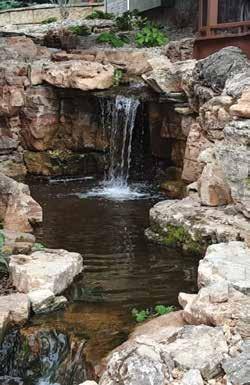



Happy honeysuckle plucking!

Some insect babies need fresh meat to develop. However, dead ar thropods decay quickly and would not be available to insects hatching from eggs a couple of weeks after they are laid. So, their moms cap ture prey and paralyze it, before laying an egg on it, so the prey will be fresh when their babies hatch. An example of this is the jewel wasp. Jewel wasps hunt cockroaches. The wasp mom first paralyzes a roach with a sting, then injects a toxin directly into a specific part of the roach’s brain. This allows the wasp to steer the roach to a dark, quiet, safe place where she lays her egg on the roach’s leg. The egg hatches, consumes the roach, and grows up to repeat the cycle. I’m not a fan of roaches, but I can’t help but feel sorry for the critters!
To sneeze, animals need a breathing system like what we have. When we sneeze, our lungs are compressed by muscles in our chest and abs which produce that noisy blast of air out our mouth. Insects breathe through tiny holes in their abdomens called spiracles, rather than their mouths. Insects do not have lungs, either. So, sneezing (and coughing) is not something in sects are able to do, which is a good thing for all the pollinating insects that might otherwise have hay fever!
Yes, some insects can be pro lific farters! In fact, termites are well known to be quite gaseous, contributing over 12 million tons of methane each year! Cockroaches are another insect with a lot of gas. Roaches and termites eat a high fi ber diet and have microbes in their gut that digest the food they eat. These microbes give off methane gas that is released through the insects’ anus. Not all insects are known to break wind, and there
are many insects that we simply don’t know if they cut the cheese. This has been going on for a long time – there are examples of insects preserved in amber (fossilized tree resin) with tiny flatulent bubbles emerging.
I just learned about an insect that gives new meaning to “silent, but deadly!” The beaded lacewing is a tiny insect that lives in termite nests. This insect takes farting to a
ever, scientists who study this in the lab find that the male is often a willing accomplice to this grue some sacrifice, somersaulting into the females grasp. To answer your question, we need to know why the female eats the male. It turns out that that by sacrificing himself, the offspring are more likely to be his, and they will be healthier because the mom-to-be is well-fed! But that doesn’t mean the next guy to come
occur, they usually cause a small wound that heals on its own. Only 10% of bites may case a serious wound that can take 2-4 months to heal. In very rare cases (<1%), a true medical emergency injury can occur, usually in young children.
Recluse spiders are just that –reclusive. They do not seek you out. Rather, they hide in sheltered locations such as under things or in crevices. If that happens to be your
whole new level by using the gas to disable their prey – termites. Ter mites typically overcome nest in vaders, but when this lacewing lets it rip, termites are unable to move. This allows the beaded lacewing to move about freely and consume termites at will.
Do female black widows eat the males even after she has eaten something else?

Female black widow spiders are known to eat their mate, although this is not always the case. Some times the male can get away. How
around is safe! She is just as likely to eat him, too.
Other arthropods are known to have similar male-sacrificing mat ing rituals. Although, some male insects have found ways to avoid being eaten by bringing the female a gift to eat, instead of offering themselves as the next meal.
What happens if you get bit by a brown recluse?
A bite from a brown recluse might not be noticed at first, or you might feel a sharp pinprick sensa tion. Bites are rare, and if they do
clothes or shoes on the floor, you could be in for a surprise when you put them on. If for no other reason, this is a great excuse to keep your room clean!
Do you have questions about bugs found in your garden for Dr. Bug? Send them to ReallT@ Missouri.edu or bit.ly/KidsAsk DrBug. Include your name and age. To help me learn what you learn from this monthly column, would you please consider fill ing out this survey: bit.ly/Kid sAskDrBugSurvey. Thank you!


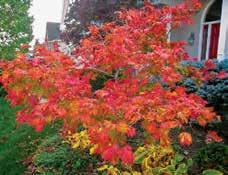
















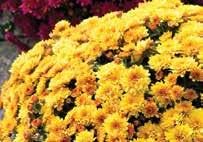






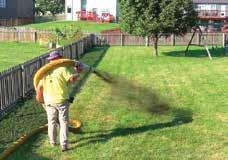

Watering indoor plants is certainly no epic en deavor, but just like any other maintenance item around the house, it’s an easy task to de fer until tomorrow. One day be comes two, then three, then a week or even more. And while that may not be the downfall of your average Croton or Snake Plant, inadequate watering of edible plants can have a tremendous impact on the quantity and quality of their output. Procras tination isn’t the only threat though, there’s also that well-earned vaca tion you want to take or that busi ness-trip you’ve been dreading.
You can certainly give your green-thumbed neighbor the ga rage door code and ask them to stop in once every couple of days, but wouldn’t it be nice to have a bit more freedom and not be forced to rely on someone else? I certainly think so! Fortunately, there are a number of tools available to auto mate indoor irrigation that I’d gen erally classify into three categories: 1) Passive, 2) Electrical and 3) Me chanical.
Passive systems rely on natural forces such as gravity or wicking. Although they are the least precise of the three categories, they’re also the simplest, cheapest and easiest to implement. In a gravity-fed system, a reservoir or container is placed above the plant’s grow medium and allowed to drain down to the plant’s roots. This can be accom plished with irrigation tubing and drippers above the soil’s surface, but most commonly it takes the form of a full water bottle turned upside down and attached to a stake placed in the soil. As the soil dries, water is released. Wicking systems, on the other hand, work in opposi tion to gravity by placing water in a container below the plant. Absor bent material such as rope connects the soil above to the water below. A force known as capillary action

allows water to pass up through the rope, rehydrating the soil as it dries.
Electrical systems offer a high level of precision but can often be quite expensive and susceptible to failure, especially in the event of
rigation line is a mechanical valve that’s influenced to open or close based on the level of saturation in the soil. One common valve made of ceramic is placed in the soil and shrinks as it dries out, caus ing it to open. After the surround
to refill the tank. Once it reaches the proper level, the valve closes, shutting off the flow. By refilling the reservoir, as opposed to rout ing the tap water directly to your plants, you provide a staging area where fertilizers and pH balancing
a power outage. An electric pump pressurizes water, forcing it out of a reservoir through irrigation tub ing, eventually being released from drippers that control the flow. The system can either run continuously or periodically by connecting the pump to an electrical timer. In ei ther scenario, faulty drippers, tim ers or pumps have the potential to either overwater or underwater your plants.
Mechanical systems use a combination of natural forces and valves that open or close based on outside forces, other than electrici ty. Not only do these systems avoid the risks presented by power out ages, but they also do a great job of watering only when needed. A reservoir filled with water is placed slightly higher than the plant it’s intended to supply with irrigation lines or tubes leading from the tank to the soil. At the end of each ir
ing soil is thoroughly saturated, it too rehydrates and expands to close the flow. Another valve uses a float connected to the base of each plant’s container. After the soil is fully saturated, the float rests atop a small pool of water. As the soil dries, the float follows the dry ing water until it reaches a speci fied point, opening a valve and flooding the soil back up to full saturation.
Whichever system you choose, the size of bottle, container or res ervoir holding your water has the potential to limit how long your plants can be left unattended. One way to overcome this constraint is by connecting the cold-water lines in your house directly to your ir rigation setup. Tap water is piped into your reservoir, where a float valve controls its flow. When the floating bobber sinks too low, the valve opens, allowing fresh water
solution can be added prior to de livery. You also minimize the risk that a faulty valve sends highly pressurized water streaming into every single plant’s container. If the float valve becomes stuck open, flooding will only occur directly at the reservoir. A best practice would be to place your reservoir in an area with a floor drain nearby. Person ally, I also use a flood sensor con nected to my home security system to receive alerts if I have an acci dental water mishap.
Automated watering may also involve a combination of the three methods. As an example, if a res ervoir can’t be placed higher than your plants, a water pump can be set to continuously pressurize wa ter through the irrigation lines and mechanical valves at the end of each line can be set to only allow that water to reach the soil when it’s needed.
Jason Mispagel is the co-owner and operator of Year-Round Garden, a grower’s supply center serving both home and commercial customers since 2016. To contact Jason, call 816-216-6917 or jason@year-roundgarden.com.







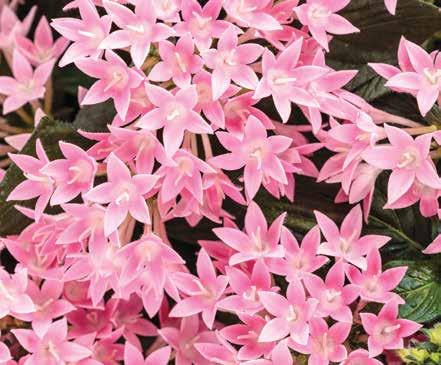
While caring for the thousands of plants at the garden center, I notice well which spe cies and varieties fly out the door to be planted in the beds of happy gardeners. Salvia, begonias, spirea, and hydrangeas (to name a few) never seem to stay in the store for long. Conversely, we note which plants aren’t moving. It is not be cause a particular plant is not wor thy of being planted; we often find that some of our very favorite va rieties just aren’t as popular as we would like them to be! They sim ply are overlooked. My intention here is to bring back into focus a few plants to consider for your next garden plan.
Annuals like Pentas are a great choice for sunny areas and work well in mass plantings, as well as in combo containers. Available in shades of pink, red, and white, they are butterfly and humming bird magnets. If attracting hum mingbirds is your goal, consider a Mexican Petunia (Ruellia). This isn’t a substitute for a trailing pe tunia; plants can actually get quite large (up to 3 feet tall and wide if planted in the ground in full sun). Trailing plants are important to any combo (think thriller-spiller-filler), and Evolvulus makes for a full, blue trailing plant in sunny hanging baskets and combos.
Looking for trailing plants to utilize in shade combos, other than the usual vinca vine? Lamium, or Dead Nettle, gives a silver-green contrast to shade pots with the added bonus of occasional pink blooms. Some varieties like ‘Bea con Silver’ are actually perennial
shade groundcovers in this zone. Perennial gardening is tricky for many. Planning to have color in an area throughout the season is a challenge when most peren nials only bloom for a few weeks at a time. One way to add inter est is by choosing a plant that has unique foliage and structure so that it adds to the landscape even when it is not in bloom. ‘Hummelo’
to landscape with our increasingly hot summers, and the challenge is planting flowers that can survive the heat all season so that garden ers can enjoy a late-summer to fall bloom. Heliopsis (False Sunflow er) is a great way to add splashes of gold to sunny landscapes. Plant amongst purple coneflowers and coreopsis and enjoy a late sum mer bloom of gold. Finding but
It will bloom well as long as it gets a couple hours of light each day.
Need a showy shrub that will thrive in a wide range of light con ditions? ‘Blue Mist’ Dwarf Fother gilla is a unique plant that is per fect for partial shade. Some sources claim that it can take more sun, but in our hot Kansas City summers, they will thrive best when shaded during the afternoon hours. Grow ing to about 3 feet tall and wide, its beautiful blue summer foliage and fall color makes it a fun specimen in landscapes; just make sure to amend the soil with compost when planting. Another fothergilla to think about is ‘Legend of the Fall.’ With stunning fall color, it is versa tile and shade tolerant. For garden ers looking for a new alternative to the well-loved Spirea, consider planting Abelia. Available in sev eral varieties and sizes, Abelia tol erates full sun to part shade. Use in masses or low borders in welldrained soils. ‘Kaleidoscope’ is the most popular variety, though others are frequently available.
Stachys (Lamb’s Ear) is one such plant for sunny beds. It does not have the fuzzy foliage as does its cousin, but it has unique, arrow head-shaped leaves that grow in a perfect mound, making it a perfect border plant or specimen in a but terfly garden. When it blooms in summer, pink blooms are sure to attract pollinators.
Sunny areas are problematic
terfly- and hummingbird-friendly plants for part sun and shadier ar eas is always a challenge, even for the experienced gardener. Chelone (Turtlehead Plant) blooms late in the summer (August-September) with unique pink flowers and is a favorite with many of my col leagues. It creates a bushy plant, about 2 feet tall and wide, making it an ideal specimen for part shade.
For many gardeners, there re mains plenty of gardening time this fall, finding the soil workable un til a freeze. So, you may still find available the perennials and shrubs mentioned here at local garden cen ters. If not, include them in your garden planning for next season.
When you do go to select your plants, be sure to ask your local garden center professionals about their favorite, often overlooked plant. We absolutely love helping gardeners think outside the box and find something new and different. You never know, it may become your favorite too!


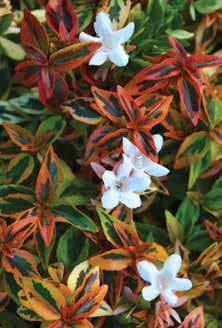
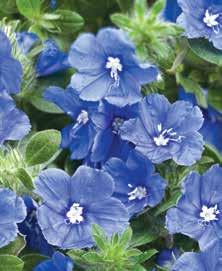
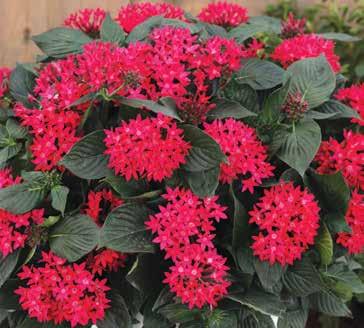
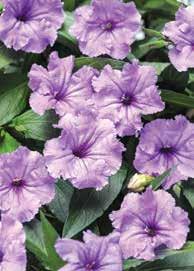
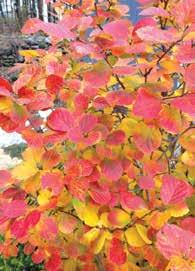
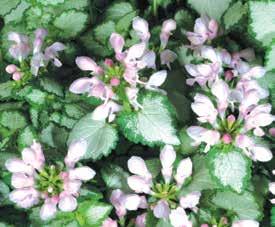




In August of 2014, a group of sci entists and allies unsuccessfully petitioned to have the Monarch butterfly protected under the En dangered Species Act. However, the Monarch moved closer to being declared in danger of extinction in August, 2022 when “The Interna tional Union for Conservation of Nature” added the migrating Mon arch butterfly to its “Red List” of threatened species and categorized it as “endangered.” Note that the non-migrating Monarchs in Central and South America are not con sidered threatened, it is only the unique migrating Midwest popu lation of Monarchs that is at risk. However, the United States still has not listed the Monarch as an endan gered species. Maybe that’s fortu nate. Read on!
The Midwestern Monarch but terfly population has declined by almost 90% since 1994, caused pri marily by the elimination of milk weed from GMO corn and soybean fields in the Midwest. However, millions of Monarchs still under take this arduous 3,000-mile annual journey. Let’s begin in early spring in Mexico. After wintering in the mountains of central Mexico, grav id female butterflies migrate back north across the Gulf of Mexico and lay their eggs on milkweed along the coast of the U.S. And then they die. The eggs hatch into the very hungry caterpillars who then form chrysalids for metamorphosis into adults with wings and genitalia. The adults are not hungry, they are horny! After multiple copulations, the now gravid females fly north to lay their eggs on milkweed. These “reproductive phase adults” live about three weeks with procreation as their sole function. The third generation of reproductive adults fly as far north as the latitude of
Ontario, hopefully not further since this is the northernmost range for milkweed. The lusty ladies lay their eggs and die, but when their off spring emerge from their chrysalids as adults, they have no interest in sex! They remain chaste and begin the flight south to Mexico. These are the migrating phase, the “Su per Monarchs”, which are brighter orange and larger than the repro ductive phase. They live as long as
The native milkweeds are gone so Tropical Milkweed is the necessary food. Simultaneously, the migra tory phase is flying south through Kansas. The Supers’ changes in be havior and appearance are caused by cues in the late summer envi ronment that impact the feeding caterpillar and maturing chrysalis. The actual flight south is triggered by cooling temperatures and length of daylight. Scientists don’t yet

The U.S. “Endangered Species Act” is administered by two Fed eral agencies. The National Marine Fisheries Service is responsible for marine species. For freshwater and land species, the U.S. Fish and Wildlife Service (FWS) adminis ters the listing process and enforces the protections as defined by the Act. It takes an average of 12 years to achieve listing for any species submitted by scientists. Forty spe cies have become extinct while on the wait list.
The powers of the FWS on behalf of listed species are draco nian. If the FWS lists the Monarch, its mandated impact on midwest ern agriculture could be devastat ing for the hungry people around the world that depend on our mid western grain. Many scientists and economists urge that the Monarch not be listed but that more ecofriendly agricultural practices be voluntarily implemented to protect pollinators and humans. But where will the Monarch find enough milkweed to sustain its popula tion? Not in our agricultural fields; farmers can’t relinquish Round-up or GMO crops. Not along our pol luted roads. Not in our National Parks.
eight months and put their energy into flight rather than reproduc tion. Reproductive phase Monarchs only fly north and migratory phase Monarchs only fly south until the females return to the U.S. in March to lay eggs along our Gulf shores.
In the Kansas City area, we see both phases in September. The re productive adults are still mating and laying eggs. September is my most prolific caterpillar month.
know why our U.S. subpopulation of Monarchs migrates instead of remaining in their tropical home. Wouldn’t that be easier? Native and naturalized Monarch populations thrive throughout the world. Some, like in Australia, have migratory patterns, but most do not. Mon archs in general are not in danger of going extinct, but we will lose the unique Midwestern migration if action is not taken.
Yes, there is a best hope for Monarchs and for ourselves. But it is not a government agency, it is each of us. Doug Tallamy describes his vision for “Homegrown Na tional Parks” in his newest book, Nature’s Best Hope. If all home owners would replace half of their lawns with milkweed and other na tive plants, we could regenerate the lost populations of Monarchs, bees, birds and other wildlife. And we could save ourselves by preventing the impending collapse of the food chain.











When the mornings are cool, and your summer plants look tired, it can only mean one thing. HALLOW EEN IS COMING! Okay, it also means that Fall is on the way. But for Halloween enthusiasts like us, we get the urge to start decorating for Halloween! Since you are read ing this article to learn more about plants, why not merge the two? Can you decorate for Halloween with plants? With a little imagination and research, of course you can! Eric Perrette, Lead Horticulturist and Becky Carbonell, Senior Gar dener are the creative team behind many of our seasonal installations and came up with these fun ideas.
This Fall at Powell Gardens we are turning our Menu Garden, Gar den Gallery Greenhouses, and Apple Court into a “Scary” garden. This display is a wonderful place to visit first when you are at Powell Gar dens to walk our annual Dark Forest exhibit presented by Quixotic.
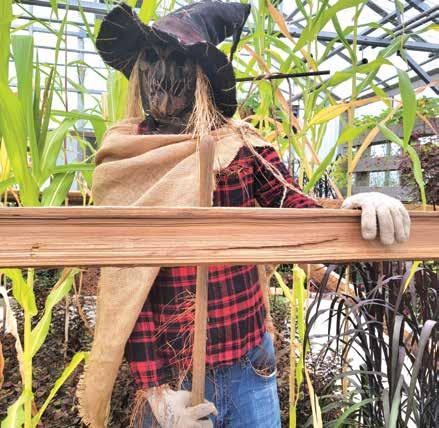
So, what elements should you consider with your plants to make a garden seem scary or eerie? Pick ing plants specifically for their name, color, and texture are key.

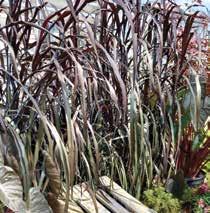
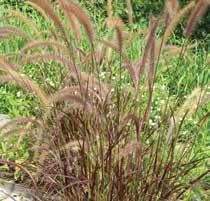
The name of a plant can mean everything when you have a theme in your garden or display. In our Garden Galleries Fall display this year we are growing...
Corn ‘Bloody Butcher’ has dark burgundy ears against vibrant light green foliage. It is an antique white corn named for the flecks of red mixed against the white kernels, like a butcher’s apron. A must-have if it can be grown in a protective place. Raccoons will destroy corn the moment cobs are forming.
Pumpkin ‘Casperita’. Get it? Like everyone’s friendly ghost! Where else should tiny ghost pumpkins grow other than along the ceiling of a greenhouse? We planted these pump kin vines in high plantar boxes and attached trellis netting stretching to the center of the ceiling.
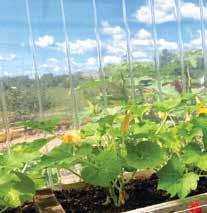
In Fall, you traditionally see colors of red, orange, yellow, and some dark purples for the season.
When creating a “scary” look to
your fall garden, consider using these colors but pay close attention to the shade or tone of the color that you are using. In the Menu Garden at Powell, we are using red shades
that are the closest we can get to a true “blood” color.
Strawflower ‘Copper Red’ has bright red-orange bracts that unfurl to reveal a glowing golden yellow center atop tall slender stems.
Dianthus ‘Dash Crimson’ is a cool season annual that has fragrant clusters of deep dark red blooms. This color of red is almost spot on for the color of blood.
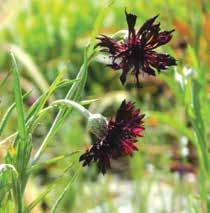
Another perfect “scary” color to use in this type of garden is black/ dark purple. A true black colored flower or plant can be harder to come by. A lot of plants labeled as black, are actually very dark purple. At Powell, we have incorporated
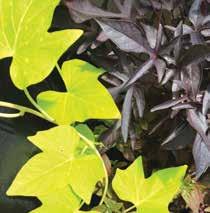

With over 25 years in the horticulture industry and public gardening community, Susan is Director of Horticulture at Powell Gardens. Married, with grown children and a granddaughter, Susan and her husband love to travel and want to see the world. Or, as much of the world as is covered by their frequent flyer miles. As long as there is a garden or two included in each vacation spot, her suitcase and camera bag are packed.

several dark purple plants to give the display a dark and eerie feeling.
Kale ‘Black Magic’ has a long, dark, and crinkled leaf, and can get up to 2 feet tall. This plant makes a bold statement in the garden. Al though the leaves are not black as the name suggests, they look like a mix of green and grey. Catch the light exactly right and the leaves may even have a hue of blue.
Cornflower ‘Black Button’ has a dark maroon, almost black, ed ible flower on a slender stem of grey-green foliage. This is the per fect plant for this kind of garden. It loves cooler weather, has a dark flower, and the foliage has droopy long leaves.
Pennisetum purpureum ‘Vertigo’ has spiky black/purple foliage that can reach 7 feet tall and makes a big architectural statement in this type of display. It also adds a lot of height to your garden. Plant in the Spring to achieve the height and full poten tial of this awesome grass!
Sweet Potato Vine Sweet Caro line Raven and Light Green are dif ferent colored sweet potato vines that have creeping/trailing foliage that are dark purple and chartreuse, respectively. The green is a perfect Halloween color and when you put these two next to each other you get a nice contrasting effect that SCREAMS!
The texture of a plant contrib utes to the overall design but also identifies the mood of your garden. Using large or coarse foliage plants gives a rough and rugged feel to an area. If you use finely cut leaves, they give more of an airy and deli cate feel to the garden.
Cabbage ‘Violaceo Di Verona’ is an heirloom cabbage from the Verona region of Italy, chosen for its violet-colored veins running through heavily textured yellowgreen leaves. This plant will make a fantastic addition to a scary garden because once it produces a head of cabbage, it looks like a huge eyeball.
Chinese Cabbage ‘Miss Hong’ is a napa cabbage. The dark red dish-purple crinkled leaves have contrasting white stalks and veins. You can create a huge contrast in your garden when placing this plant next to other green foliage plants.
Coleus ‘Black Dragon’ has dark velvety textured leaves with a rich red center darkening to almost black scalloped edges.
Lettuce ‘New Red Fire’ has
ruby red ruffled leaves and works well as an edger in your garden.
Also, a nice salad or snack while you are outside!
Pennisetum setaceum ‘Rubrum’
Purple fountain grass has a dramat ic spiky and fluffy appearance and can be used as a tall accent plant. It is a bronze-purple grass with arch ing pinkish-purple inflorescence. A
nice grass to plant in the Spring and let it grow and mature all Summer and be ready for Fall!
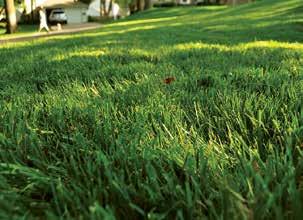
We have given you 13 (a scary number!) plants that you should use in your “scary” themed garden for Fall. But what other elements can you add to take it up a notch on the scary?
Try using dead sticks that have a lot of zig zag movement and stick
them vertically in the ground to add a more scary look, especially in the evening. Set out some rusty old tools so it looks like the gardener has not been around in years. You can also try making your own scarecrow, a scary one. If you want inspiration, come and visit our nightly guard on display in our Garden Gallery Greenhouses this Fall and through Dark Forest!
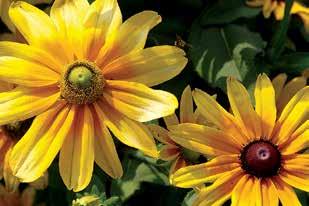
I’m often asked, “Why should I get a soil test?” The first key to lawn and garden success is knowing soil fertility.
A soil test reveals the baseline nutritional values of your soil. A test can determine the type and amounts of fertilizer needed for optimal plant health. A good soil test also determines the pH level of the soil so corrections can be made.
Soil fertility is something that cannot be seen, felt or guessed. It varies from one yard to the next. In many cases the test shows that too many nutrients have been applied and additional chem ical elements such as phosphorous and potassium may be harmful.
Phosphorous and potassium levels build up in KC soils. Excess can harm growth, or worse, leach out and pollute streams and lakes. Many garden resources recommend a balanced fertilizer such as 10-10-10 or 5-10-5. Long term use of these products can lead to chemical buildup. Soil testing takes the guesswork out of fertilizing.
A common misbelief is that our local soils need lime. Lime raises the pH, and most KC soils
already have high levels. A simple soil test will determine soil pH. You’ll then learn the correct treatment options, saving you money.
Extension recommends a soil test every three to five years. All local extension offices provide soil testing services. Soil samples brought or mailed to the Johnson County Extension office are sent to the Soil Testing Laboratory at Kansas State University in Manhattan. I analyze the lab results and write a personalized recommendation. Your report is usually mailed to you in two to three weeks.
Soil amendments made this fall will help you get a jump-start next spring. Save yourself time and money by getting your soil tested today.
It’s been a beautiful summer…and now you smell a hint of fall in the air and your thoughts are turn ing to pumpkins and warm cozy nights by the fire. Still, it’s not time to hang up your rake until the last gardening tasks of the season are complete. Here are ten essential fall tasks to finish before the snow flies
1. Evaluate your garden spaces
Take a good look at your garden. Where could you add new plants to create a private, outdoor oasis? How can you extend your garden’s season-long color, or add winter in terest? Whether you choose to plant now or later, fall is a great time to plan and prepare your outdoor ar eas so you can jump right into gar den projects next spring.
2. Divide and conquer.
Decide which plants need to be divided and/or moved to a bet ter spot. Many plants will tolerate this activity just fine in the fall. Just be sure to have the spot where you want to transplant ready so you can drop the plant into its new home as soon as it’s uprooted.
3. Rid annuals from containers.
It was a great run, but by the time fall rolls around, it’s time for the annuals to go and to clean and store your pots away for winter. Healthy annuals can be composted.
4. Cut perennials back.
Once your perennials have gone dormant, it’s a good idea to clean at least some of their foliage out of garden beds. This is especially important around plants like hos tas that have received slug damage during the growing season.
Wait until spring to prune shrubs, especially hydrangeas. A good rule of thumb for these boda cious bloomers is, when in doubt, don’t prune! Although panicle hy drangeas like Limelight Prime®
and smooth hydrangeas like In crediball® can be cut back by 1/3 every spring without affecting flowering, it isn’t strictly necessary to prune hydrangeas. You can leave their flowers intact for winter inter est, and simply dead head them in the spring.
5. Dispose of diseased foliage; compost the rest.
While most of the annuals emp tied from pots and cut back foliage
The date that your ground actually freezes varies from year to year, of course, and some areas won’t have frozen ground at all. If you’re un sure, mid-November is a safe plant ing deadline for nearly everyone.
7. Don’t forget the bulbs!
Get those spring flowering bulbs in the ground now and you’ll be rewarded with bright, cheerful color next year, when winter sub sides. Tulips, daffodils, crocuses,
Just as you pile on blankets and quilts when the temperatures dip, mulch acts as insulation for plants. While even established plants ben efit from a nice layer of mulch, newly planted specimens especial ly appreciate the protection it of fers from the challenges of winter. Shredded leaves make an excellent mulch for this purpose.
10. Bring the outdoors in. Fall is the perfect time to gath er cut branches and dried flowers from the garden to use in your in door decorating projects. Hydran gea flowers, colorful branches, and plants with seed pods can all be brought indoors this time of year.
When you are just starting out, knowing when to plant can be in timidating. But don’t worry, Moth er Nature is really pretty forgiving. The perfect time to plant isn’t just one or two days. Prime planting time goes on for weeks. So, relax, enjoy the sunshine and feel the dirt in your hands!
Here are four Proven Winners® ColorChoice® shrubs that are perfect for fall planting:
can go in your compost pile, you don’t want to risk spreading dis eases back into your garden in the spring. Bag and seal any diseased plant material and dispose of it in the trash.
6. Fall is for planting!
Still-warm soil and relatively cool air temperatures promote healthy root growth in plants that return each year. Although broad leaf evergreens like azaleas and boxwood should wait until spring, you can plant many varieties of shrubs and perennials up to 6 weeks before your ground freezes.
and more are already on display at your local garden center. Pair them with small shrubs like dwarf butter fly bush, and perennials like hostas or catmint, so the bulbs’ foliage will be hidden by the time they go dormant.
8. Provide supplemental water.
Autumn weather can be quite cool and rainy, but that doesn’t mean that new plantings should be ignored, particularly if weather has been dry and/or windy. Water all plants thoroughly after plant ing, and continue to water them as needed until the ground freezes.
Roses (Rosa) Try the Oso Easy® line of beautiful, low maintenance, disease resistant, roses. Oso Easy Double Red® rose is 3-4’ tall and wide and hardy down to zone 4.

Smooth hydrangeas (Hydrangea arborescens) Try the Invincibelle® line of super-hardy hydrangeas. Invincibelle Wee White® hydrangea is just 1-2.5’ tall and wide and is hardy down to zone 3.
Panicle hydrangeas (Hydrangea paniculata) Try Fire Light Tidbit® (USDA 3-8) It’s the smallest panicle hydrangea on the market, reaching heights/widths of just 2-3’, so it will fit just about anywhere!
Spirea (Spiraea) Try Double Play Doozie®, which reblooms all summer without shearing. It reaches heights/ widths of 3’ and is hardy down to USDA zone 3.



Natalie is rooted in horticulture, having worked in the family floral business until college, where she earned her degree in fine and theatrical arts. Now, an avid gardener, writer, and public speaker for Spring Meadow Nursery, Natalie delights in sharing her expertise and enthusiasm about the art of garden ing, using Proven Winners® ColorChoice® flowering shrubs.


Another rose growing sea son is coming to a close. Continuing to deadhead will interfere with the process of shutting down for winter. Instead, just pluck the spent petals off but leave the rest in place. Fall blooms will generally be bigger and the colors more intense than in the summer; so, yes, go ahead and cut blooms to enjoy indoors. Remember to continue watering if there is not one inch of rain per week.
they a disappointment? Visit the Laura Conyers Smith Municipal Rose Garden in Loose Park to see which roses did well there. This will give you ideas for roses to replace underperforming ones in your own garden.
Fall is a good time to prepare the soil for spring planting. Start by obtaining a soil test, which can be done through the local Exten sion Office. Roses do best when the soil pH is between 6.0 and 6.5. Adjusting pH can start as part

Gardening remains one of American’s most popular pastimes – it is good for the heart and soul! Want to learn more to make your garden grow next year? Enroll in the fall Extension Garden Stewards course by MU Extension. Basic horticulture knowledge will help you succeed in growing a beautiful garden while improving your environmental stewardship. This shortened version of the Extension Master Gardener Training course will be offered online Wednesdays, Oct. 26 - Nov. 30, 3:30-4:30pm (5 sessions, no meeting Nov. 23).
The focus is on the basics: site assessment, vegetable gardens and food safety, care of ornamentals, insects and IPM, and environmental stewardship. No volunteering is required unless you wish to join as an AmeriCorps Senior. Scholarships are available. For more information, contact MU Field Specialist in Horticulture Dr. Tamra Reall, reallt@ missouri.edu or Horticulture Instructor Cathy Bylinowski, bylinows kic@missouri.edu. To access the registration form, visit this linkhttps://extension.missouri.edu/events/extension-garden-steward

Black spot is a common dis ease of roses that we are usually concerned about as temperatures rise in damp weather in the spring. The infection often times seems to lessen in the heat of the summer; but it can reappear as temperatures moderate in the fall, especially if there is abundant rain and if antifungal spraying has tapered off or stopped as the season progressed. So, if black spot is a problem in your garden, antifungal spraying should be continued into the fall. To reduce the emergence of black spot next spring, remove leaf litter and infected leaves before providing winter protection.
Now is a good time to assess how your roses did during the growing season. How well did they grow? How well did they bloom? Did they lose most of their leaves to black spot? Were


of initial soil preparation. Nitro gen, phosphorus and potassium can be added during the growing season, but should not be used in the fall. In our area most soils can benefit from added organic matter, usually in the form of compost. This is accomplished by incorporating a 2- to 4-inch layer of organic matter into the top 12 inches or so of soil. If bare root roses are going to be planted, holes for them can even be predug in the fall.
Further information about rose care can be found at www. kansascityrosesociety.org/grow ing-roses. Specific questions can be sent to kcrosehelp@gmail. com. And, information about any of the roses grown in the Laura Conyers Smith Municipal Rose Garden at Loose Park in Kansas City, MO can be accessed at www.kcroselibrary.com.
Glenn is an Extension Master Gardener in Johnson County, KS, an American Rose Society (ARS) Master Rosarian, and an ARS Accredited Horticulture Judge. He has been growing roses in Lenexa, KS since 1974 and successfully exhibiting roses since 1998.

Sat, Oct 1, open at 9:30a, meeting starts at 10a; at the Woods Chapel Community of Christ Church, 500 NE Woods Chapel Rd, Lee’s Summit, MO 64064. Guests are welcome. Our speaker is hybridizer Bob Solberg, from North Carolina.
Garden to Glass: Beer Edition
Sat, Oct 1, 3-4p; at Powell Gardens. $25 | 10% less for members; Terrace Room. Join us and taste some beer! While tast ing 4 different styles of beer, attendees will learn about the brewing process and what goes into making beer. Attendees will also take home a Powell Gardens pint glass. Must be 21+ to register. Reg istration link can be found at powellgar dens.org/calendar.
Kaw Valley Farm Tour
Oct 1 & 2. The Kaw Valley Farm Tour is an opportunity to visit local farms and learn about farm practices directly from the farmer. Go to Kawvalleyfarmtour.org for more information and tickets.
Raytown Garden Club
Tues, Oct 4, 10a; at Connection Point Church, 10500 E 350 Hwy, Raytown, MO 64138. Program will be A Common Sense Approach to Growing and Using Herbs, presented by Bernie Zeller. Guest are always welcome. For more infor mation please check out our Facebook page: https://www.facebook.com/Ray townGardenClub
Fall Tree Seminar
Wed, Oct 5, 7p; at Meadowbrook Club house, Birch Room, 9101 Nall Ave, Prai rie Village, KS. Majestic trees provide shade and beauty to Prairie Village and other parts of the metro area, but will they always? Are there things that can be done to prolong the lives of these older trees? How long can we expect these trees to live? The Prairie Village Tree Board has lined up a panel of four speak ers to address what we can do to save our trees. Writer and Horticulture agent for Johnson County K-State Research and Extension Dennis Patton, Board Certi fied Master Arborist Ivan Katzer, Subur ban Lawn & Garden Vice President Matt Stueck, and Program Manager of the Heartland Tree Alliance Sarah Crowder will all bring their expertise to this im portant topic. Past generations made the mistake of using a single variety of tree such as the American elm and green ash to line our streets only to see the tree can opy decimated by disease. The panel of speakers will discuss about what kinds of trees we should be planting to replace them. The public is invited to attend free of charge.
Creating a Child’s Sensory Garden
Thurs, Oct 6, 11:30a-1p; sponsored by Wyandotte County Extension Master Gardeners. Register at this link: https:// ksu.zoom.us/meeting/register/tJ0o fu6qrDsqEtMVT_MWlu-KkXYQIJX
8FAPB Or call the Wyandotte County Extension Office 913-299-9300. Chil dren learn about their environment through their senses, acquiring knowl edge of the natural world. In this pro gram, Pamela Hubbard shows how she created a simple sensory garden with her little friend, Lucy. She gives tips for gardening with children, including planning, tools, and safety issues. Pam explains some of the design consider ations for sensory gardens for children and adults. She suggests suitable plants that enliven the senses of sight, hearing, touch, smell, and taste. In addition, she describes some wonderful year-round gardening activities for children that will pique their interest and teach them gar dening principles. Ms. Hubbard is a gar den coach offering tips and advice for the home gardener on all manner of garden and plant related issues. She is a master gardener emerita, frequently asked to train new gardeners for Penn State Ex tension. She was born in England, where she acquired the love of gardening at her grandmother’s knee. Her gardens have received three blue ribbons from the Pennsylvania Horticultural Society; they were featured in the Summer 2020 edition of Country Gardens Magazine. She can be found, endlessly pursuing her dream of recreating her grandmother’s cottage garden, at a small farm in the Po cono Mountains of Pennsylvania.
Garden to Glass: Goldenrod Edition
Sat, Oct 8, 3-4p; at Powell Gardens. $15 | 10% less for members; Terrace Room. Make tea out of the abundant fall plant, goldenrod. In this edition of Garden to Glass, attendees will learn to make gold enrod tea at home. Each attendee will take home a special Powell Gardens mug. Registration link can be found at powellgardens.org/calendar.
Heartland Peony Society
Sat, Oct 8, refreshments at 9:30a, 10a program begins; at Asbury United Meth odist Church, 5400 W 75th St, Prairie Village, KS 66208. Guest speaker is Lois Girton, an expert on AP Saunders peo nies. Program topic: The Best of Saun ders Peonies. Her collection includes nearly 200 of his hybridized creations. Open to the public.
Oak: Their Role in the Ecosystem and Human History
Sat, Oct 8, 11a-noon; at Powell Gardens. $10 | 10% less for members; Conifer
Room. Join Missouri Master Naturalist, Lee Ann Googe, to learn all about oak trees. After a brief presentation, the class will tour some of the oaks that call Pow ell Gardens home. Registration link can be found at powellgardens.org/calendar.
Growing Orchids Under Lights Sun, Oct 9, Orchid Society of Greater Kansas City beginner’s group is 1:302:15p, and the general meeting and speaker is scheduled at 2:30p; at the Merriam Community Center, 6040 Slater St. Alan Koch of Gold Country Orchids, Sacramento, CA, is scheduled to speak via Zoom on “Growing Orchids Under Artificial Light.” The meeting is open to the public.
Greater Kansas City Iris Society Mon, Oct 10, 6:30p; at the Trailside Cen ter, 99th Street and Holmes, Kansas City, MO. For more info, visit KCIris.org.
Sho-Me African Violet Club Fri, Oct 14, 11a; at Loose Park Garden Center, 51st St and Wornall Rd, Kansas City, MO. Club meeting. Visitors wel come.
Pollinator Habitat 101 Fridays, Oct 14-Nov 11, 11am; 5 sessions on creating pollinator habitat! FREE, Register: https://osu.zoom.us/webinar/ register/WN__y1hvBGcRC28dybWX
ThGgQ
Family Frolic: Halloween Edition Oct 15 & 16, 9a-5p; at Powell Gardens. Included with general admission. Join us for a weekend of family fun! Cel ebrate the last weekend of Fortopia and all things Halloween at Powell Gardens. Pumpkin carving and spooky animals will be joining us for the weekend! Reg istration link can be found at powellgar dens.org/calendar.
Cactus, Succulent Talk on Botany Sun, Oct 16, 1:30p; at Trailside Center, 99th and Holmes, Kansas City, MO. The Kansas City Cactus and Succulent Soci ety meeting. A plant trade and giveaway and a talk on botany are scheduled. For more information on the organization, visit KCCactus.com.
Olathe Garden & Civic Club Tues, Oct 18, 10a-4p; Location: Atchi son, KS (details below) *Free to attend, Club membership not required* Please join us for a field trip to the Interna tional Forest of Friendship in Atchison! Optional carpool leaves at 10a from the Price Chopper at K-7 & 135th St in Olathe. Optional lunch and club meeting at 11:30a at Jerry’s Again restaurant (125 N 5th St #2406, Atchison, KS 66002).
Tour begins at 1p at the International Forest of Friendship (more info at https:// ifof.org/). Hope to see you there!
Fall Gardens–Collect, Divide & Prepare for a Long Winter Nap Tues, Oct 18, 6:30-7:30p; at Tonganoxie Public Library, 217 E 4th St, Tongan oxie, KS 66086. Joseph O’Neill, a Leav enworth County Master Gardener, will give a presentation on collecting seeds from annuals; identifying which plants need to be dug up, stored and divided. He will also go over other tasks to per form as your gardens prepare for a long winter’s nap. The meeting is free and open to the public. For more information contact the Leavenworth County Exten sion office at 913-364-5700.

African Violet Club of Greater Kansas City
Monthly meetings: Oct 28, Nov 18, Dec 16, 11a-1p; at Jacob L Loose Park Gar den Center, 51st & Wornall, Kansas City, MO 64112. Visitors Welcome.
The Orchid Society of Greater Kansas City presents a regional orchid show and sale on Oct 29-30 at the Merriam Com munity Center, 6040 Slater St. It will be a judged American Orchid Society show. Its theme is “Bewitched by Orchids.” Orchid societies from surrounding states will be participating with displays of blooming orchids. Vendors will sell or chids for collectors and other orchid growers. There also will be educational displays and literature to encourage nov ice growers. The public is welcome. Ad mission is $5. Hours are 10 a.m. to 5 p.m. Saturday and 11 a.m. to 4 p.m. Sunday.
African Violet Club of Greater Kan sas City 70th AVSA Judged Show and Sale: “Calling All Violets” Nov 5, 9a-3p; at Jacob L Loose Park Garden Center, 51st & Wornall, Kansas City, MO 64112. No Admission Fee.

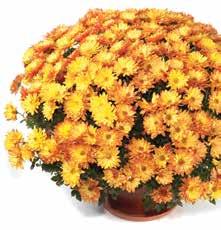

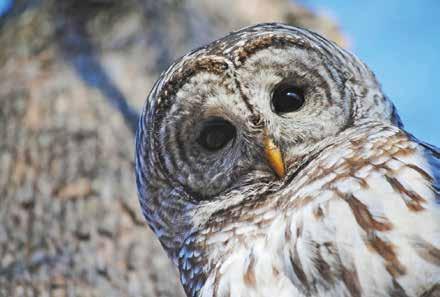






• Recommended mowing heights for blue grass and tall fescue in the fall are 2 to 3 inches.
• Core aerate if not already done to help loosen heavy clay soils and break down thatch.
• Fertilize now if not already done in Sep tember.
• Dandelions, henbit, and chickweed are easy to control in the fall, treat as needed.
• Sharpen mower blade if it is not making a clean cut, or after every 10 hours of use.
• Rake leaves as they fall to avoid winter suffocation of turf.
• Mulch mow leaves back into the lawn if debris is not covering the surface.
• Fall is an ideal time to plant tulips, daffo dils, and other spring flowering bulbs.
• Clean up faded annuals.
• Trim perennial stems to tidy garden and keep disease and insects in check. OR
• Leave perennial stems to provide nesting materials for native solitary bees, benefi cial pollinators.
• Pot bulbs for winter forcing.
• Dig tender bulbs such as dahlias, gladiolas and cannas and store in a cool, dry place over the winter.
• Update the garden journal for successes
and failures while fresh in your mind.
• Take advantage of fall sales and plant new perennials.

• Divide overgrown perennials.
• Plant new trees and shrubs.
• Water establishing plants over the winter during dry spells.
• Seedlings of trees and shrubs can be safely transplanted once dormant.
• Prune damaged and dead wood from trees and shrubs.
• Wrap the bases of young trees and shrubs to protect from rabbits.
• Rake leaves and compost or use as garden mulch.
• Remove tree stakes if in place longer than one year.
• Store unused seeds in a cool, dry location.
• Pick up and discard fallen fruit to reduce disease and insects for next year.
• Fall planted garlic gets a jump over spring planted.
• Dig sweet potatoes and cure for a week or two in a warm location then store for winter.
• Harvest peanuts and roast.
• Harvest apples and pears and store for winter use.
MY GARDEN (Use this space to list additional tasks to accomplish in your garden.)
• • •
•
• Store winter squash and pumpkins in a cool, dry place.
• To prepare for next spring, till garden soil to help control insects and disease.
• Make notes of successes and failures.
• Soil test and make improvements.
• Bring houseplants indoors for a long winter stay.
• Begin long night treatments for poinsettia re-blooming.
• Check plants for insects and treat as needed.
• Wash dust from leaves by placing in a shower or wiping with a damp, soft cloth.
• Reduce or stop fertilization over the winter months.
• Keep plants away from hot and cold drafts of winter.
• Drain and store garden hoses and sprin klers for winter.
• Spruce up the compost pile for winter by adding new materials promoting decompo sition.
• Clean, sharpen and oil garden tools for winter storage.
• Do your part for clean water! Don’t mow, sweep, or blow leaves or grass clippings onto the street.
Johnson County K-State Research and Extension recommends environmentally-friendly gardening practices. This starts by identifying and monitoring problems. Cultural practices and controls are the best approach for a healthy garden. If needed, use physical, biological or chemical controls. Always consider the least toxic approach first. Dennis Patton is the horticulture agent for Johnson County K-State Research and Extension. For free information fact sheets, visit www.johnson.ksu.edu, or call the Extension office at 913-715-7000.

Children learn about their environment through their senses, acquiring knowledge of the natural world. In this program, Pamela Hubbard shows how she created a simple sensory garden with her little friend, Lucy. She gives tips for gardening with children, includ ing planning, tools, and safety issues. Pam explains some of the design considerations for sensory gardens for children and adults. She suggests suitable plants that enliven the senses of sight, hearing, touch, smell, and taste. In addition, she describes some wonderful year-round gardening activities for children that will pique their interest and teach them gardening principles.
Ms. Hubbard is a garden coach offering tips and advice for the home gardener on all manner of garden and plant re
lated issues. She is a master gar dener emerita, frequently asked to train new gardeners for Penn State Extension. She was born in England, where she acquired the love of gardening at her grand mother’s knee. Her gardens have received three blue ribbons from the Pennsylvania Horticultural Society; they were featured in the Summer 2020 edition of Country Gardens Magazine. She can be found, endlessly pursu ing her dream of recreating her grandmother’s cottage garden, at a small farm in the Pocono Mountains of Pennsylvania.
Call the Wyandotte County Extension Office, 913-2999300, to obtain the Zoom link or register at:
https://ksu.zoom.us/meeting/reg ister/tJ0ofu6qrDsqEtMVT_MW lu-KkXYQIJX8FAPB
Extension Master Gardeners are ready to answer your gardening questions.
CASS COUNTY 816-380-8494; Wed, 9am-noon
DOUGLAS COUNTY 785-843-7058; dgcogardenhotline@gmail.com; Mon, Wed, Fri, 1-4pm
GREATER KANSAS CITY MISSOURI AREA 816-833-8733 (TREE); Mon-Fri, 9am-noon; mggkc.hotline@gmail.com
JOHNSON COUNTY, KS 913-715-7050; Mon-Fri, 9am-4pm; garden.help@jocogov.org
JOHNSON COUNTY, MO 660-747-3193; Wed, 9am-noon
LEAVENWORTH COUNTY 913-364-5700; Leave a message. A Master Gardener will contact you.
MIAMI COUNTY & LINN COUNTY 913-294-4306; Thurs, 8am-noon
WYANDOTTE COUNTY 913-299-9300; Mon, Wed, Fri, 9am-4pm
Ask a Rosarian; kcrosehelp@gmail.com; www.kansascityrosesociety.org
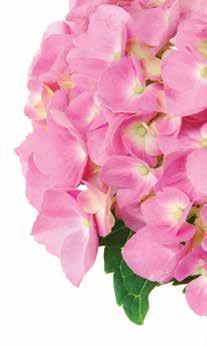
We are looking for friendly, enthusiastic people to fill positions at our Lenexa, Overland Park and Kansas City locations.

Fountian Sales/ Install
General Labor
Garden Pharmacy
Horticulturist
Outdoor Hardgoods Manager


Mechanic
Tree Planting Crews
Plant Sales
Fax resume to 816-941-3838
Email resume to suburban@suburbanlg.com
Apply in person at our Corporate office. 13635 Wyandotte // Kansas City, MO 64145
Questions? Contact Human Resources at 816-941-4700. suburbanlg.com // facebook.com/suburbanlg
For convenient mail delivery, complete the form below and send with your check for $35.00. You will receive a oneyear subscription.
Name:
Address:
City, State, Zip:
Phone: E-mail:
Where did you pick up The Kansas City Gardener?
Please enclose your check payable to The Kansas City Gardener and mail with this form to: P.O. Box 8725, Prairie Village, KS 66208
The Kansas City Gardener is published monthly Jan. through Dec.

